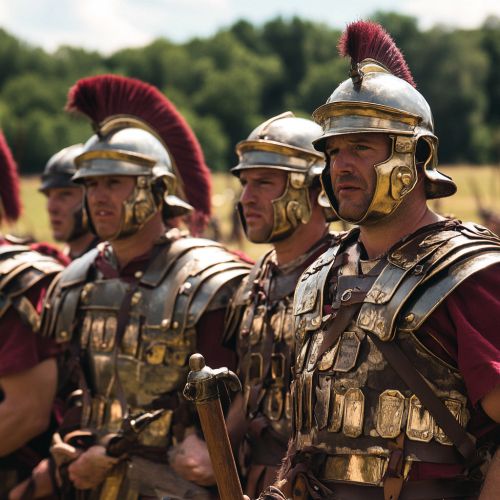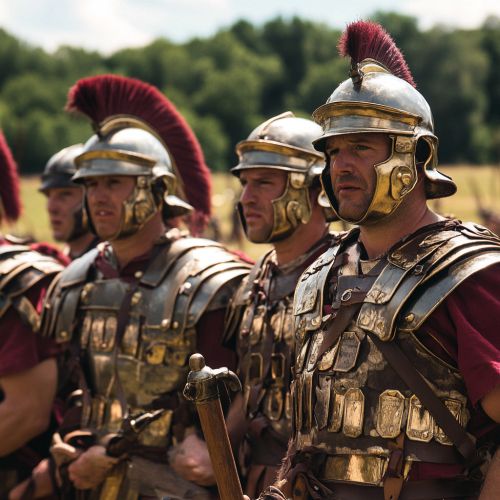Roman Auxiliary
Roman Auxiliary
The Roman Auxiliary, or Auxilia, were non-citizen troops in the Roman military who played a crucial role in the expansion and maintenance of the Roman Empire. These troops were distinct from the Roman legions, which were composed of Roman citizens. The Auxilia provided the Roman army with additional manpower and specialized skills, including cavalry, archers, and light infantry. This article delves into the history, organization, roles, and significance of the Roman Auxiliary forces.


Historical Background
The origins of the Roman Auxiliary can be traced back to the early Republic, where non-citizen troops were often recruited from allied states and conquered territories. However, it was during the reign of Emperor Augustus (27 BCE - 14 CE) that the Auxilia were formally organized into a distinct military corps. Augustus' military reforms aimed to create a more professional and permanent standing army, and the Auxilia were a key component of this new structure.
The Auxilia were initially recruited from the provinces of the Roman Empire, where local populations were often more familiar with the terrain and tactics of the region. This local knowledge made the Auxilia invaluable in various military campaigns. Over time, the Auxilia became more standardized, with units being organized into cohorts and alae, each with its own command structure and equipment.
Organization and Structure
The Roman Auxiliary units were organized into several types, each with specific roles and responsibilities. The primary types of auxiliary units included:
- **Cohortes**: These were infantry units, typically composed of 500 to 1,000 men. They were often equipped with lighter armor and weapons compared to the legionaries, making them more agile and versatile in battle.
- **Alae**: These were cavalry units, usually consisting of 500 to 1,000 horsemen. The cavalry played a crucial role in reconnaissance, skirmishing, and flanking maneuvers during battles.
- **Cohortes Equitatae**: These mixed units included both infantry and cavalry, providing flexibility in various combat situations.
- **Numeri**: These were irregular units recruited from tribal or semi-nomadic groups. They often retained their traditional fighting styles and equipment.
Each auxiliary unit was commanded by a prefect or tribune, who was usually a Roman citizen. The soldiers in the Auxilia were typically recruited for a term of 25 years, after which they were granted Roman citizenship as a reward for their service.
Recruitment and Training
Recruitment for the Auxilia was conducted throughout the provinces of the Roman Empire. Potential recruits were often drawn from local populations, including those from recently conquered territories. The promise of Roman citizenship and land grants upon completion of service was a significant incentive for many recruits.
Training for auxiliary soldiers was rigorous and aimed to ensure that they could operate effectively alongside the Roman legions. This training included drills, physical conditioning, and instruction in Roman military tactics and discipline. Despite being non-citizens, auxiliary soldiers were expected to adhere to the same standards of discipline and loyalty as their legionary counterparts.
Roles and Responsibilities
The Roman Auxiliary played a variety of roles within the Roman military, complementing the capabilities of the legions. Some of the key roles and responsibilities of the Auxilia included:
- **Cavalry Operations**: Auxiliary cavalry units were essential for reconnaissance, skirmishing, and pursuing fleeing enemies. Their mobility allowed them to perform tasks that were difficult for the heavily armored legionaries.
- **Specialized Combat**: Auxiliary units often included archers, slingers, and other specialized troops who could provide ranged support during battles.
- **Garrison Duty**: Many auxiliary units were stationed in frontier regions, where they served as garrison troops. Their presence helped to maintain Roman control over these areas and deter potential invasions.
- **Engineering and Construction**: Auxilia were frequently involved in construction projects, including building fortifications, roads, and bridges. Their labor was crucial for the infrastructure of the Roman Empire.
Equipment and Armament
The equipment and armament of the Roman Auxiliary varied depending on the type of unit and the region from which the soldiers were recruited. However, there were some common elements across most auxiliary units:
- **Armor**: Auxiliary infantry typically wore lighter armor than the legionaries, such as chainmail (lorica hamata) or scale armor (lorica squamata). Cavalry units often wore a combination of mail and scale armor for better mobility.
- **Weapons**: The primary weapons of auxiliary infantry included spears (hasta), swords (gladius or spatha), and javelins (pilum). Cavalry units were equipped with lances, swords, and sometimes bows.
- **Shields**: Auxiliary soldiers carried oval or rectangular shields (scutum), which provided protection while allowing for greater maneuverability.
- **Helmets**: Helmets varied widely, but many auxiliary soldiers wore the Montefortino or Coolus type helmets, which offered good protection and visibility.
Integration and Identity
The integration of the Auxilia into the Roman military was a complex process that involved balancing the distinct identities of the auxiliary troops with the need for cohesion and discipline. While auxiliary soldiers retained some of their cultural practices and traditions, they were also expected to adopt Roman military customs and loyalty to the Roman state.
The granting of Roman citizenship to auxiliary soldiers upon completion of their service was a significant factor in their integration. This policy not only incentivized service but also helped to assimilate diverse populations into the Roman Empire. The children of former auxiliary soldiers often became Roman citizens, further strengthening the ties between the provinces and the central Roman authority.
Notable Campaigns and Contributions
The Roman Auxiliary played a crucial role in many of the Empire's military campaigns. Some notable examples include:
- **The Conquest of Britain**: Auxiliary units were instrumental in the Roman conquest and pacification of Britain. Their knowledge of local terrain and tactics was invaluable in dealing with the various British tribes.
- **The Dacian Wars**: During the Dacian Wars under Emperor Trajan, auxiliary troops provided essential support to the Roman legions, including engineering and siege operations.
- **The Jewish Revolt**: Auxiliary units were heavily involved in the suppression of the Jewish Revolt (66-73 CE), providing both combat and logistical support.
Legacy and Impact
The legacy of the Roman Auxiliary is evident in the lasting impact they had on the Roman military and the broader Roman society. The integration of non-citizen troops into the Roman army helped to create a more diverse and adaptable military force. The granting of citizenship to auxiliary soldiers and their descendants contributed to the Romanization of the provinces, fostering a sense of unity and shared identity within the Empire.
The Roman Auxiliary also left a lasting mark on military organization and tactics. Their use of specialized troops and flexible unit structures influenced later military developments in both the Roman and post-Roman worlds.
